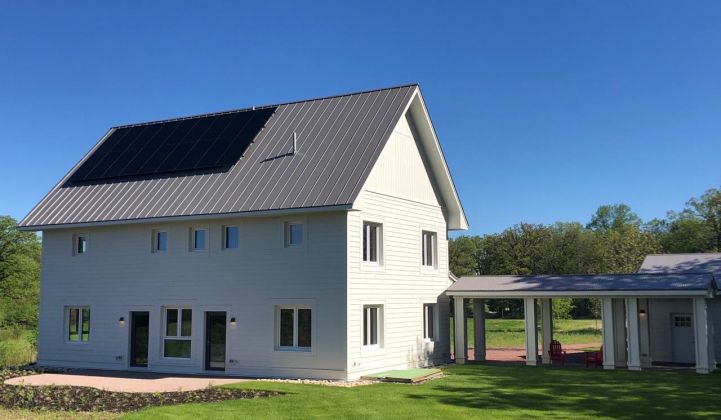The U.S. branch of battery company sonnen will move into the Illinois market to supply an entire residential development of environmentally friendly houses with high-end energy storage systems.
Sonnen will outfit each house with a 20-kilowatt-hour ecoLinx battery system in an upcoming development by Evolutionary Home Builders. The 28-home "Wildwood of Marengo" project, located due west of Chicago, will meet the standards of the Passive House Institute United States, and feature a 120-acre ecological restoration of the surrounding prairie.
Evolutionary has finished the model home and will move ahead with development this summer, said founder Brandon Weiss.
In its home market of Germany, sonnen operates a network of thousands of residential batteries that function as a distributed power plant. That achievement helped win the attention of Shell, which acquired sonnen in February.
The U.S. regulatory landscape hasn't allowed a direct replica of that business model, so sonnen's local branch prioritized partnerships with homebuilders to put batteries in each unit of a neighborhood development.
The company first partnered with Mandalay Homes to outfit a 2,900-home development in Arizona. Then came Pearl Homes, which wants to put sonnen systems in a 148-home community in coastal Florida, followed by an even larger rental project.
Why sonnen picked Illinois
Illinois makes for an unexpected followup, because it has seen minimal residential storage activity to date. Its 108 megawatts of installed solar capacity puts the state 36th in the nation for that resource, according to the Solar Energy Industries Association, although the group expects precipitous growth in the next five years.
On top of that, electric rates in utility ComEd's territory, where Wildwood will be, do not encourage storage adoption.
"ComEd's residential rates are cheap and they don't have time-of-use rates," said energy storage analyst Brett Simon of Wood Mackenzie Power & Renewables. "However, as we well know, emotion has driven a fair amount of residential storage deployment in the U.S."
Time-of-use rates can encourage storage adoption because they charge more for peak power and less for midday power; that creates a price signal to store midday solar generation for use in the evening. ComEd does offer an unusual hourly pricing rate pegged to the wholesale markets; it's unclear how that would impact home battery economics.
Even without those price signals, Weiss said he wants to design the homes so that they add value to the grid rather than stressing it. Simply dumping each house's 6-kilowatt generation capacity onto the grid at noon could one day contribute to a "duck curve" effect, if Illinois follows through on plans for a massive renewables scale-up.
Instead, he wants his customers to be able to store their production with the ecoLinx batteries and use it when the system is more strained by demand.
"Being able to reduce peak power demand is really cool," Weiss said. "We want to do the right thing ecologically and from a sustainability standpoint."
Banking on future grid value and backup power
The combined energy storage capacity of the homes will surpass half a megawatt, which could be a nontrivial amount for local grid balancing during peak events. That said, sonnen did not announce any formal agreement with ComEd to put that capacity to work for grid services.
This mirrors the earlier sonnen homebuilder projects, where the company decided to move ahead with construction in the absence of a utility contract, banking on there being future value in the portfolio of dispatchable batteries. If the homebuilder can sign up customers looking for a self-sustaining lifestyle, then future utility revenue will just be an added bonus.
Clean backup power for the all-electric homes will also attract customers in Illinois, Weiss said. The Midwest climate will throw snowstorms, ice storms, high winds and hail at the houses, which lack a gas hookup to feed a generator. But the battery will be ready to step in.
The ecoLinx model is the top-shelf version of sonnen's product suite, because it can interact with high-end home automation systems and respond automatically to incoming storms that might knock out power to the grid. Weiss said he liked that the product has the flexibility to let homeowners choose whichever home automation platform they prefer.
Sonnen's higher price point presents a challenge in a market with cheaper options such as the Tesla Powerwall and the LG Chem Resu. That dynamic is visible in data from California's Self-Generation Incentive Program, which subsidizes small-scale storage. Of the home batteries installed with that incentive last year, Tesla and LG Chem split the pool almost fifty-fifty, with sonnen picking up 1 percent, according to WoodMac's Energy Storage Monitor.
Partnering with specialized homebuilders lets sonnen wrap the price of its systems into the overall home purchase. This symbiosis also enables homebuilders to pitch environmentally conscious customers on self-sufficient clean energy, which needn't meet the standard of strictly economic return on investment.
Perhaps most importantly for sonnen, it means that winning over one counterparty can unlock hundreds or thousands of unit sales, a far more efficient approach than selling customer by customer.




